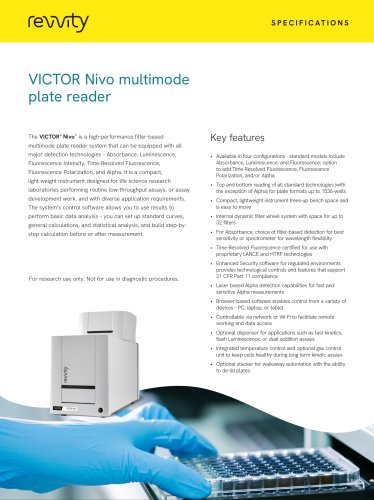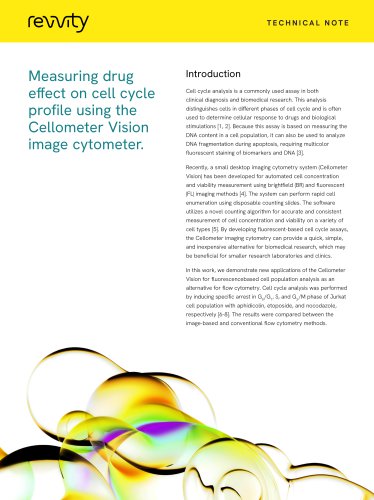 Website:
revvity
Website:
revvity
Group: PerkinElmer
Catalog excerpts

Introduction The hemacytometer persists as the gold standard for laboratory cell counting. First utilized in 18th century France as a means to analyze patient blood samples, the hemacytometer has gone through a series of major developments over the past hundreds of years, creating a modern instrument that is more accurate and easier to use than its predecessors. The hemacytometer remains an integral part of all cell-based research, and yet sources of error inherent in its design and utilization persist. Those sources of error will be outlined here, followed by a discussion of how automation can be employed to eliminate many of these potential pitfalls. Sources of hemacytometer error 1. Human error (mixing, handling, dilution, miscalculation, and procedural errors made by humans) a. In a study using five observers, errors due to operator and random error were 3.12%, and 7.8%, respectively.3 b. James M. Ramsey performed an experiment to measure how sampling area and dilution factors affected variation in cell counts. He tested three area sizes (18, 9, and 4 mm2) and two dilution factors (1:100 and 1:25). CVs increased as the sampling area decreased. Higher dilution factors also generated lower CVs.4 c. Bane found that if the same operator was to count duplicate sperm samples, the variation in the results was attributed to 55% of sampling and pipetting error and 45% of chamber and counting error.5 Freund and Carol published additional measurement to show that variation amongst different operators could be as high as 52% and there could be a 20% variation resulting from a single operator.5 rewty 2. Need for multiple cell sample counts to ensure statistical accuracy a. In 1907, John C. DaCosta stated that it was necessary to measure multiple drops of blood samples.1 b. Nielsen, Smyth, and Greenfield concluded that in order to obtain an accuracy of 10%, 15%, and 20% in hemacytometer counting, the number of samples necessary were 7, 3, and 2, in addition to, 180, 200, and 125 cells counted per sample, respectively.6 c. In 1881, Lyon and Thoma approximated the hemacytometer's standard error to be ——, where n was n the number of cells counted. d. In 1907, William Sealy published his work counting brewer's yeast under the name of "Student", where he specifically calculated the statistical variation through experimentation and mathematical modeling, 7, 8 which resulted in the same equation ■ .
Open the catalog to page 1
Identifying and resolving the sources of hemacytometer counting error through automation 3. Need for uniform distribution of cells a. In 1912, James C. Todd cited non-uniform distribution of cells as sources of error.1 b. Student also stated that there are two main sources of error, one was related to obtaining yeast samples that may not be representative of the bulk solution, and the error of random sampling where the cells were not uniformly distributed in the observation area.7- 8 c. 1947, an article was published on variation in cell density due to non-uniform distribution in the...
Open the catalog to page 2
Identifying and resolving the sources of hemacytometer counting error through automation References 1. Davis JD. THE HEMOCYTOMETER AND ITS IMPACT ON PROGRESSIVE-ERA MEDICINE. Urbana: University of Illinois at Urbana-Champaign; 1995. 2. Verso ML. Some Nineteenth-Century Pioneers of Haematology. Medical History 1971; 15(1): 55-67. 3. Biggs R, Macmillan RL. The Errors of Some Haematological Methods as They Are Used in a Routine Laboratory. Journal of Clinical Pathology 1948; 13. Al-Rubeai M, Welzenbach K, Lloyd DR, Emery AN. A Rapid Method for Evaluation of Cell Number and Viability by Flow...
Open the catalog to page 3
Identifying and resolving the sources of hemacytometer counting error through automation 22. Chan LL, Wilkinson AR, Paradis BD, Lai N. Rapid Image-based Cytometry for Comparison of Fluorescent Viability Staining Methods. Journal of Fluorescence 2012; 22: 1301-11. 24. Chan LL-Y, Lai N, Wang E, Smith T, Yang X, Lin B. A rapid detection method for apoptosis and necrosis measurement using the Cellometer imaging cytometry. Apoptosis 2011; 16(12): 1295-303. 23. Chan LL, Zhong X, Qiu J, Li PY, Lin B. Cellometer Vision as an alternative to flow cytometry for cell cycle analysis, mitochondrial...
Open the catalog to page 4All Revvity catalogs and technical brochures
-
Model 307 Sample Oxidizer
3 Pages
-
chemagic Prepito® instrument
4 Pages
-
chemagic 360 instrument
4 Pages






















